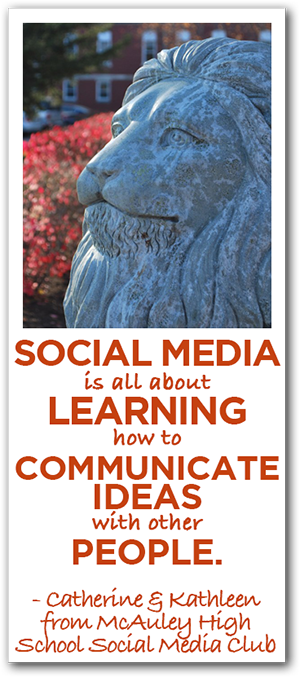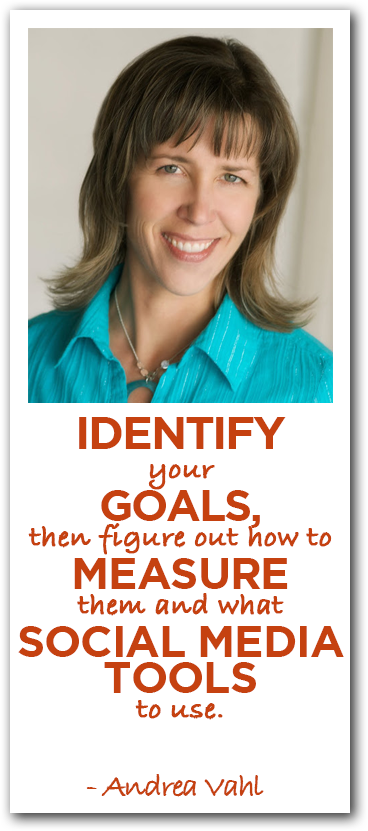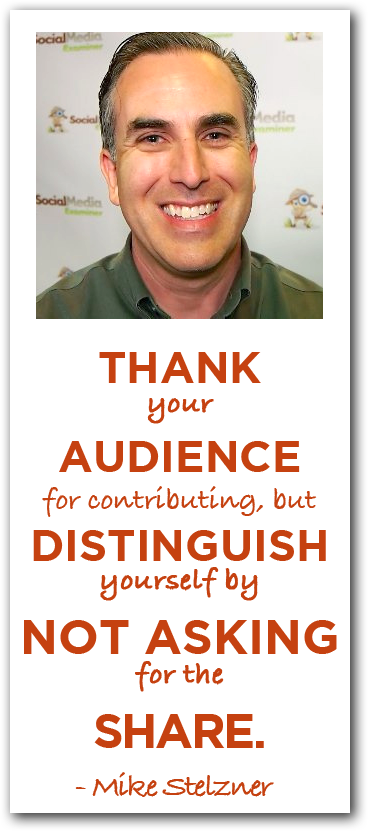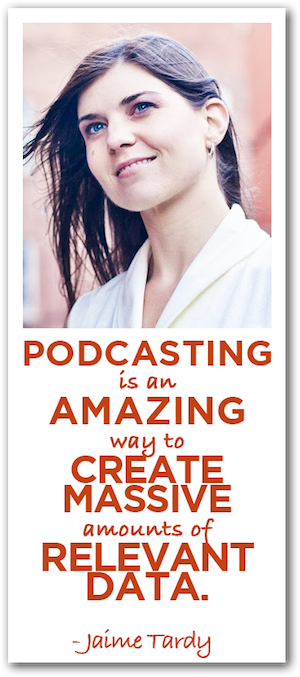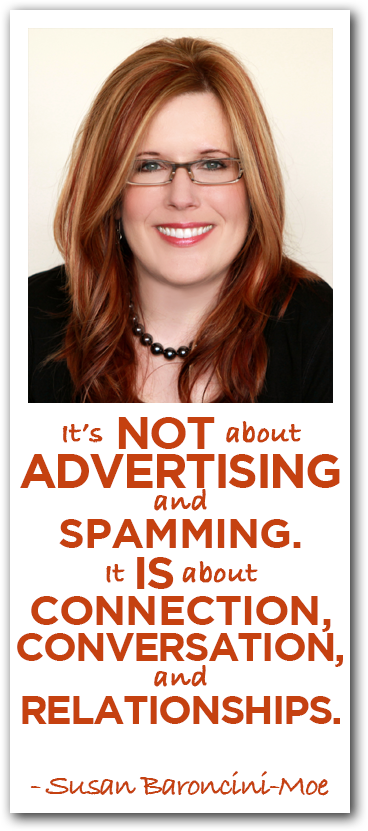 Are you better at in-person networking than online networking? Do you follow the same robotic script when meeting people at conferences or through social media? Do you have an assistant handle some or all of your online marketing?
Are you better at in-person networking than online networking? Do you follow the same robotic script when meeting people at conferences or through social media? Do you have an assistant handle some or all of your online marketing?
If this sounds like you, then you’re not alone. A lot of us have completely forgotten how to humanize and connect with others on a personal basis and turn off our “marketing brains.” We focus on getting business and not making a meaningful relationship.
This week, we bring in Susan Baroncini-Moe, author of Business in Blue Jeans, to talk about how we can focus on marketing ROI and be humans while doing it.
Podcast: Play in new window | Download
Subscribe: RSS
Big Ideas:
- So, what world record do you hold?
- I hold the Guinness World Record for the longest uninterrupted live webcast since 2012.
- The trick is you have to keep your stream going and be live the whole time.
- The record was 24 hours when we broke it and we broke it and ended up at 36 hours and 16 seconds.
- If you’re going to break something, really break it!
- There was a guy who tried it last year in England, and it didn’t go so well.
- We may embark upon another adventure and we may try to break our record someday, but for now it’s holding strong.
- You’ve written and spoken about “business in blue jeans.” Tell me a little about that and why you decided to write a book on the subject?
- I’ve been doing business consulting and marketing coaching for a long time and the fact of the matter is that it started in a place where I really didn’t want to wear a suit.
- I wanted to be comfortable and do business in the way that I do it which is rolling up my sleeves and do what I need to do. I do that best in jeans, yoga pants, and pajamas.
- I realized it’s far more than just a brand the represents me, it’s also a philosophy of doing business that is really about creating a business that has the properties of denim – it’s stable, long lasting, and it’s flexible – and like that great pair of jeans it makes you look good and feel comfortable about yourself.
- We want business to be friendlier. This is the big push right now for me.
- We want business and marketing to be approachable so businesses need to be thinking about that. “How can I reach my consumers and employees and be human and friendly.”
- What’s better for small businesses – online networking or conference networking?
- They’re different animals and there’s no one right answer. There’s no one right answer for all small business.
- It’s really dependent on your target and where you’re going to find them most and how you behave and how you handle the medium.
- If you tend to be introverted, then social media may be easier and manageable for you.
- If you’re extroverted, then certainly in-person networking makes sense, but there are pros and benefits to each side of that coin.
- Let’s start with online networking. What do you say when you hear people say “social networking sites are stupid or a waste of time?”
- If you think social media is stupid or a waste of time, then it’s one of two things – either you don’t get it yet and see how it can be applicable and useful or your target market isn’t there yet which is becoming less and less likely.
- Everybody doesn’t have to be on every social media platform, and there are some platforms that make more sense for others.
- You have to find the social media platform that makes the most sense for your business and your personality and you have to approach it with “I’m gonna play this game the way it needs to be played and the way it makes the most sense to play it and effectively play it” and see if I win.
- I’m not going to just dismiss it out of hand. It’s extremely useful.
- How can small businesses and entrepreneurs get the most bang for the buck when it comes to social media networking? What do you say to people say they want to get going and know social media is important, but aren’t sure where to start?
- The first thing is to figure out where your target market is and to understand that each platform has its own culture.
- You’re not going to go to LinkedIn and post the same way you do on Twitter. You’ll post too much and make everyone crazy. You use LinkedIn a different way.
- The first thing is to say, “am I B2B?” If you are then you’re most likely you’re going to want to be on LinkedIn. If you’re more B2C then Twitter, Facebook, more platforms may be more appropriate.
- The first step is – where should you be?
- And the second step is – how can you understand the culture of that platform so well that you can leverage it – and when you do that you’re going to be able to make connections with complete strangers, start to forge a relationship, build a connection, and then over time that can turn in to a lot of opportunities.
- I have spent the last couple weeks focusing on LinkedIn because it’s some place I haven’t spent a lot of time, and not only have I secured some speaking engagements, a couple of clients, I also am in talks with a production company.
- There are a lot of opportunities out there if you just know how to wield the right tools.
- How do we understand what the culture is of any given channel?
- Google! It’s not like the information’s not out there.
- If you want to know “how do I use Facebook most effectively” look for blogs you can trust, read the blog – does this blog have information I can use?
- Find out what they have to say about that social media platform and find out what the consistencies are and what people have to say.
- You don’t have to throw a stone very far to find a blog that will tell you if you want to be on Twitter – here are the things you need to do…be friendly, be approachable, don’t just follow everybody – these are the things you need to be focusing on.
- Same with LinkedIn, Facebook, any of those social media platforms.
- I think people would be more interested in LinkedIn if you told them how you got your speaking engagements. How did you get business out of LinkedIn? What exactly did you do to achieve that?
- One of the reasons people don’t like LinkedIn because it is structured in a way to minimize fluffy social media interaction that you see on Facebook and to maximize the more old style business networking.
- You have to figure out a way to negotiate that. A lot of people look at LinkedIn and go “hey, I’m not going to accept a connection from someone that I don’t know, who are you?” LinkedIn is kind of set up in that way, but there are a lot of ways around it.
- You have to play around in the tool and find out ways to get there. I can click connect for a lot of people and not have to say where I know them from.
- The way I use LinkedIn is that I humanize it. You can’t make it a mass tool.
- No social media is successful if you try to do everything with mass quantities of people. Just remember these are human beings and you don’t like spam in your inbox so remember they don’t either.
- So, instead of sending a million connection requests, find people that make appropriate connections for you and send them an actual personal message like, “hey, I’m looking to expand my relationships and I’m looking to meet more people and you seem like someone who would be interesting and I’d like to get an opportunity to talk with you.”
- You can actually set up a phone call or set up a time to chat.
- One of the things I’m doing now is building relationships locally because I haven’t done that a lot and I’m reaching out saying “you seem like you’re in the know, let’s have a conversation.” That’s yielded some really incredible conversations.
- So, when you are reaching out, personalize it so you humanize it. Have a conversation with people in the same way you would have a conversation at a networking event.
- Exactly. That’s the other piece of it. I could send out a million connection requests and if you approve it, so what. We haven’t built anything there. That’s just an invisible connection that we’re never going to remember.
- On the other hand, when I have a conversation with someone on the phone I take notes. So, not only do I remember what they do and who they do it for, I also remember their name, their business name. I’m really thinking about that person and I’m really thinking about ways in which I can bring value to them.
- Do I know somebody that might be an interesting person for them to talk to?
- I think that we have to be thinking in terms of “how can I bring value to them?” and not how can I get business for me.
- How do we measure the ROI of our online marketing? Do you have any tools or techniques that you use to see if the time or money you’re putting in is paying off for you?
- Man, I’m so unscientific about this.
- For me, I just get a feel for it. If I’m using a tool and I’m getting business from it then “yay, it’s working.”
- I am not great with numbers. I’m much better at marketing, so I leave the numbers to people who understand them, but I tend not to think too much about that unless I’m putting a lot of time into something and it’s not working.
- We should all be doing those sort of general calculations whether they’re with actual scientific data or a feel what you’re putting your time into and say to yourself, “look, am I putting time into stuff that isn’t working? If not, I should stop doing it and find something that is working. Replace that.”
- A lot of people outsource their online marketing and social media networking to a co-worker or a virtual assistant. Are there advantages or disadvantages?
- My assistant is local, and not virtual, but my assistant does not manage my social media for me.
- She does some outreach for me in terms of setting up, guest blogging or podcast interviews like this one. She’ll set up different opportunities for me and do outreach and schedule things for me, but she does not handle any of my social media.
- I feel strongly that for me, because my brand is so closely to me and my lifestyle, that it doesn’t make sense for me to have someone else posting for me.
- It takes more time for me to set up a list of things like tweets to schedule than to just do them myself.
- Unless I’m traveling, my assistant might be scheduling a few things for me, but other than that it’s all me.
- There are times when it makes sense to have an employee do it if they can adequately represent the brand. In larger businesses that makes sense, but for me, because my brand is so tied to me, I do it all myself.
- Are there any things we should be avoiding when it comes to online networking or social media networking?
- My god, how much time do we have? Ha!
- Yeah, I have a whole blog post I wrote – “Social Networking, You’re Doing it Wrong!”
- I think that’s super important because realistically social media is so tricky and so many people are doing wrong because they’re really just looking at it as a place to advertise. That’s not what social media is about.
- It’s not about advertising and spamming and trying to get get get business. It’s about connection and conversation and building relationships.
- If you keep that in mind and stick with that.
- Focus more on the giving and not the getting.
- LinkedIn will say 500+ connections if you’re over, but any less than that it’ll say your exact number of connections. Sometimes you need to have a critical mass to let people know you’re taking a channel seriously. Right?
- Getting to that 500 mark in LinkedIn. I don’t know about that because I’ve been past that for a long time. Is that a thing?
- I agree but we just have to be careful how we’re getting to that point.
- There’s no point of being on LinkedIn unless you’re looking to network with other people who are in the same business.
- Yeah.
- I had an acquaintance who once said that LinkedIn is kind of like that grandfather that you never talk to.
- I thought that was funny because you’re in business. Why are you not using LinkedIn? Because everyone who’s there is IN business.
- My problem with LinkedIn is that it has just become a place where I can promote my latest blog post. I think more controls and settings would be more valuable. After a while everyone is promoting there but nobody actually goes there to read anything. It becomes like drive-by marketing.
- Yeah, I don’t spend much time in LinkedIn groups. I spend my time with one-to-one connections.
- So, if I’m nervous, what can I do to best prepare for a conference for a networking opportunity for something like Social Media Marketing World?
- Okay, so the first thing I always tell my clients about stuff like this is no one knows that you’re nervous.
- Now we KNOW you’re nervous, Rich! This episode is “Rich tells all.”
- I think if you start with the premise that no one knows you’re nervous and you don’t have to tell anyone you’re nervous.
- Not only that, but everyone else is, to some extent, a little nervous as well. That’s the first piece.
- Knowing that you can talk to anyone. There’s no reason or barrier saying you can’t and everybody else is there to meet and connect with other people and have those conversations is almost a little bit freeing.
- I like to go without someone. I typically travel with husband but if I’m going to go to an event it’s easier for me to go by myself because I don’t have the crutch of being with someone and then kind of doing that thing where we hang out together the whole time. You don’t get as many relationships built when you do that.
- I suggest going alone. I also suggest starting to use the online world as a way to start forging connections in advance.
- Some of the best experiences I’ve had are when I’ve gone to an event where I knew a lot of people who were going to be there, but only from online.
- When I would get there, people would run up to me, “oh my god, it’s you!” and I wouldn’t know who it was and it’s kind of weird and you don’t really know them. But if you do it intentionally and you do it in a smart way that makes sense, you get there – it’s basically like you’re going to a party with a bunch of your friends and they’re already there and they’ve already started the conversations, so you get there and you continue to forge that relationship and strengthen that bond you’ve already started.
- One of the things people fear the most is making small talk. People are just terrified by it. Do you have any tips on how we can get over something like that? What can we talk about when we go to these conferences so we can start a meaningful conversation?
- I like to avoid talking about people’s work. I will start almost any conversation I have I almost always start with my favorite question (which I will eventually have to change because everybody’s going to be using it) – I like to open a conversation with, “So, Rich, I’m really glad that we’re talking. What’s your story?”
- The most important thing is that you open up a question that allows them to have the freedom to talk about anything that they want so they tell you a whole lot about who they are and what they value.
- It also creates a conversation and you’re going to find out an awful lot about that person just in the first couple of minutes.
- I love that question. I tend to ask people about their lives because I want to know who they are. I’m not asking about their business because I know we’re going to get to that eventually, naturally. If I start out with “what’s your story” we often don’t even get to business and it forges a relationship a lot quicker and a lot stronger.
- Is getting someone’s business card still important? And if it is, should I be trying to get their card, should I exchange cards, should I be trying to make sure they walk away with one of my cards? Or, do I just not care about this anymore?
- Business cards are still relevant. I don’t care who says they’re not. They are because you have to be remembered and you want to have an easy way to give people your contact information.
- I think they’re still relevant unless you’re at a super techy conference, then you could just bump your phones or whatever.
- Wait, is bumping an old way to do that? Ha ha…you can tell I don’t do that a lot!
- The real question is, “why are you giving them your card in the first place?”
- I only like to give people my card if there’s a reason. If we have a conversation, I’m not going to be super anxious to hand them my card. It’s more along the lines of having a meaningful conversation and then if we agree we want to have a further conversation or communication after that and I feel like that you’re somebody I want to get to know, then I’ll say that.
- What should our goal be for one of these in-person networking opportunities?
- I think it’s really important to understand that we’re all human beings.
- If there’s a business connection to be made, that’s going to merge organically. You don’t have to force it.
- The goal should be, “is this someone I want to get to know? Is this an interesting person? Is this a nice person?”
- I make it a practice to not do business with people that aren’t friendly and kind. I don’t like spending my time with anyone else.
- I don’t want to work with somebody who’s unpleasant, so I need to ferret it out whether you’re going to be a person I’m going to want to be working with in the first place. That’s the initial part of the conversation anyways – it’s getting to know the person.
- Not only that, there’s so much more to each person than their business.
- As you talk to people it’ll really emerge what they do. If you’re an accountant, it’s not like that’s rocket science. I know what you do and I can just ask you, “so who are your ideal clients you do accounting for?” That’s not hard either and we’re going to know whether there’s a business relationship here for both of us or I might know somebody that I can refer you to so I’ll ask you for card so I can can give it to someone else.
- We want to know why we’re asking for cards. We want to be looking at what the relationship is and what it could be, but we don’t want to make any snap judgements because you don’t know who somebody knows or who they’re going to be a year from now. They might be looking for you.
- If I’m speaking at an event, how can I maximize my networking opportunities?
- Good question. I really like to connect with my audience before I speak. It allows me to tailor my speech a little bit and know what their concerns are. “What’s your story” gets a lot of that out there initially.
- Even as you’re speaking you can reference someone’s conversation with you earlier and reference that to have that connection.
- After your presentation, stick around and talk to people. Don’t be a snob.
- As a conference organizer, how can I make it easier for my attendees to chat and network?
- I haven’t seen anything that blew my mind, to be honest.
- Obviously, you want to set up hashtags.
- Having a LinkedIn group for business related opportunities if it’s that kind of conference.
- Having a LinkedIn group or Facebook group can be a great way for people to connect.
- Having Twitter chats in advance.
- Having some of those opportunities to have online engagement before the event can help.
- Making it easy for people if they want to share rooms, that kind of simple stuff, is a really great way for people to connect.
- Having some virtual networking events before the actual event really helps.
- At the end of the day, what’s drives more ROI – online or offline networking?
- I think that it is a combination of the two. I don’t think that there’s one or the other.
- For me, online is great and has a huge ROI.
- I have a lot of clients that really high ROI with offline events.
- I don’t think there’s a right answer for that, it really depends on you and your business.
-
Juicy Links:
- Follow Susan Baroncini-Moe on Twitter.
- Check out Susan Baroncini-Moe’s website.
- Learn more about Susan Baroncini-Moe’s book Business in Blue Jeans.
- Connect with Susan Baroncini-Moe on Facebook.
- Connect with Susan Baroncini-Moe on LinkedIn.
- And be sure to leave a review for The Marketing Agents on iTunes
Rich Brooks
So, what’s your story?
